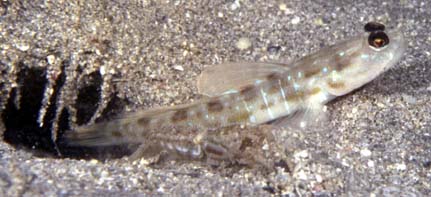|
hawaiisfishes.com
|
|
Home |
Fishes | Invertebrates |
Books | CDs
| Links |
Contact |
|
past
fishes of the month HAWAIIAN
SHRIMP GOBY
|
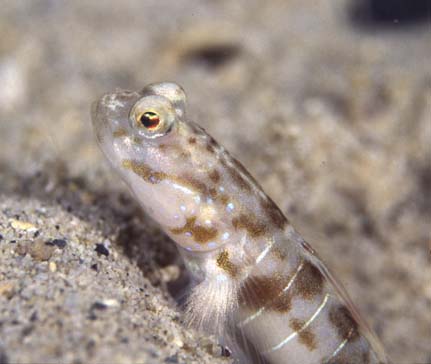 Käne`ohe Bay, O`ahu, 2 ft. |
|
HAWAIIAN SHRIMP
GOBY |
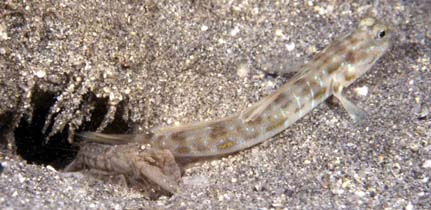 Most Hawaiian Shrimp Gobies disappear into their holes instantly at the approach of a diver or snorkeler. A few, however, don't appear to mind. The goby above, which I found off Olowalu, Maui, at about 60 ft., was one of the latter sort. It seemed amazingly unperturbed as I inched slowly up to it with my giant camera and big double strobes. I waited until the shrimp started to emerge, then snapped a shot. |
|
At the flash of my strobes, the goby retreated slightly, darkening its eye sockets, and partially raising its dorsal fin. Suspecting a predator, it was probably signaling "I see you, so don't bother to attack.” A predator, had there been one, would presumably have lost interest upon seeing the darkened eyes and raised fin, knowing that an alert goby almost always escapes; the goby, meanwhile, would save itself the energy expenditure of dashing into the burrow. Despite all this drama, the clueless shrimp continued its advance out of the burrow. I snapped another shot. |
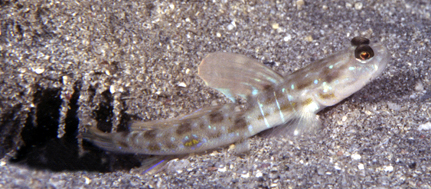 |
| After the second strobe flash the goby's dorsal shot all the way up, and the fish twitched slightly, signaling the shrimp to retreat. The goby remained on high alert at the burrow entrance until I took this final picture, after which it turned and dived into the hole. |
| The
tortured history of a fish name In 1939, while studying at the University of Hawai`i, ichthyologist Gordon B. Mainland wrote a masters' thesis on Hawaiian gobies in which he described an unusual goby from Kane`ohe Bay, O`ahu. The goby shared its burrow with a shrimp. He named it Paroxyurichthys edmondsoni after zoologist Charles H. Edmondson of Honolulu’s Bishop Museum. The name attained no formal status, however, because Mainland never published his thesis. (According to the rules of zoological nomenclature, a new scientific name must be published to be valid.) In 1946 Edmondson published a book entitled Reef and Shore Fauna of Hawaii in which he listed the goby. (Incidentally, Edmondson misspelled the genus as Paraxyurichthys, or else there was a typographical error.) The name was now formally published but, it turns out, still not valid. The deficiency was not that the name was misspelled, but that Edmondson did not include any descriptive data along with it. (According to the rules, a newly published scientific name with no accompanying descriptive data is a “nomen nudum”--a “bare” or "naked" name--and not acceptable.) Technically, the goby was still an unnamed species. Twenty five years later, in 1971, another University of Hawai`i ichthyologist, Wayne J. Baldwin, redescribed and renamed the fish, placing it in a new genus, Psilogobius, and naming it after Mainland. The genus name is from the Greek psilos, meaning "bare" or "naked," ostensibly because the goby lacks scales on the front of its body. Was this just coincidence, or was Baldwin also having fun playing with words? (Remember Edmondson's "nomen nudum?.") An interesting factoid: Had Edmondson included a description of the fish along with the misspelled name Paraxyurichthys edmondsoni, the misspelled name would have become the formal scientific name. (According to the rules, the first published two-part scientific name of an animal accompanied by descriptive data becomes its official name, even if it is "wrong.") A similar scenario actually occurred with the Whale Shark. It was supposed to have been named Rhiniodon typus, but a newspaper "scooped" the formal scientific publication and in the process misspelled the genus name as "Rhincodon." Because the newspaper account was first and contained some descriptive data, the misspelled name in the article, Rhincodon typus, became the formal scientific name. Rules is rules. |
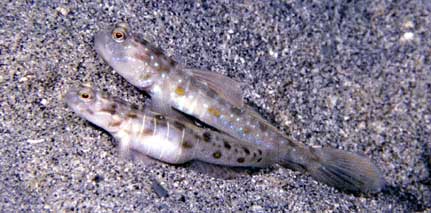 Male and female by burrow entrance. Female is swollen with eggs - Hanauma Bay, O`ahu. 8 ft. |
|
|
